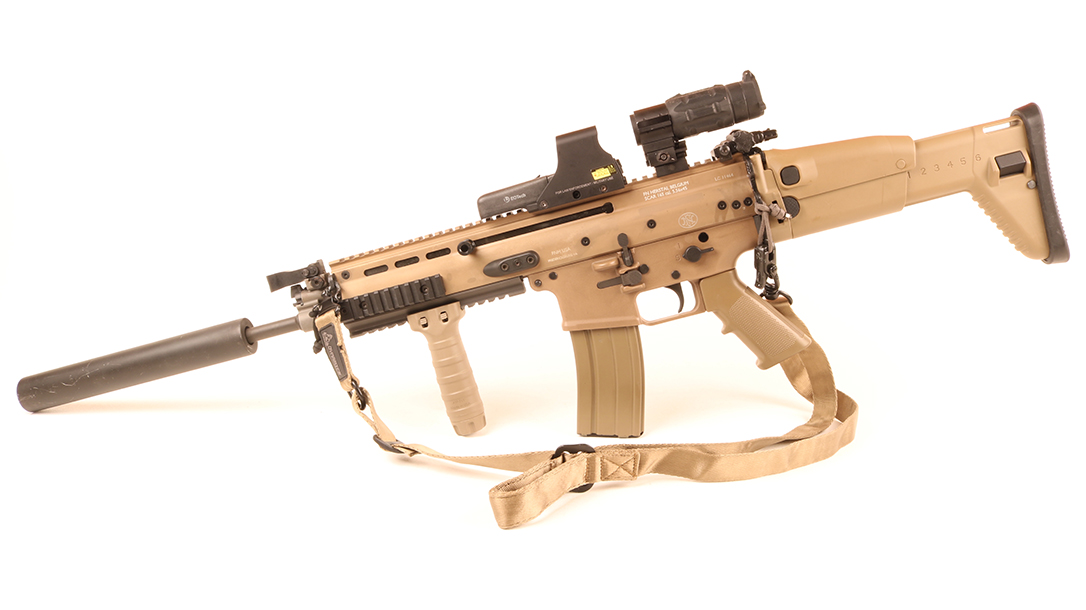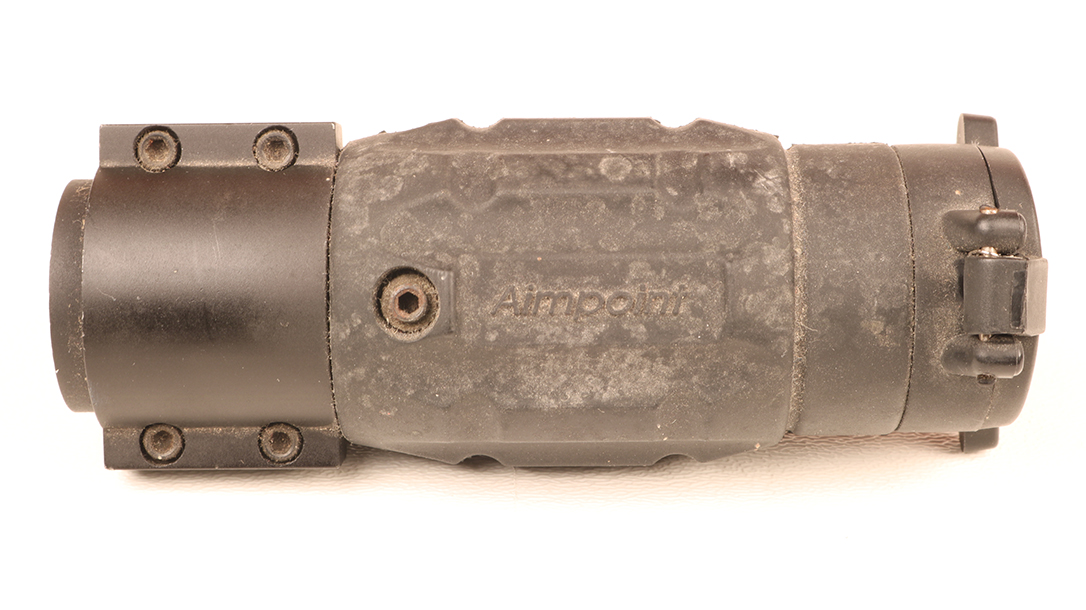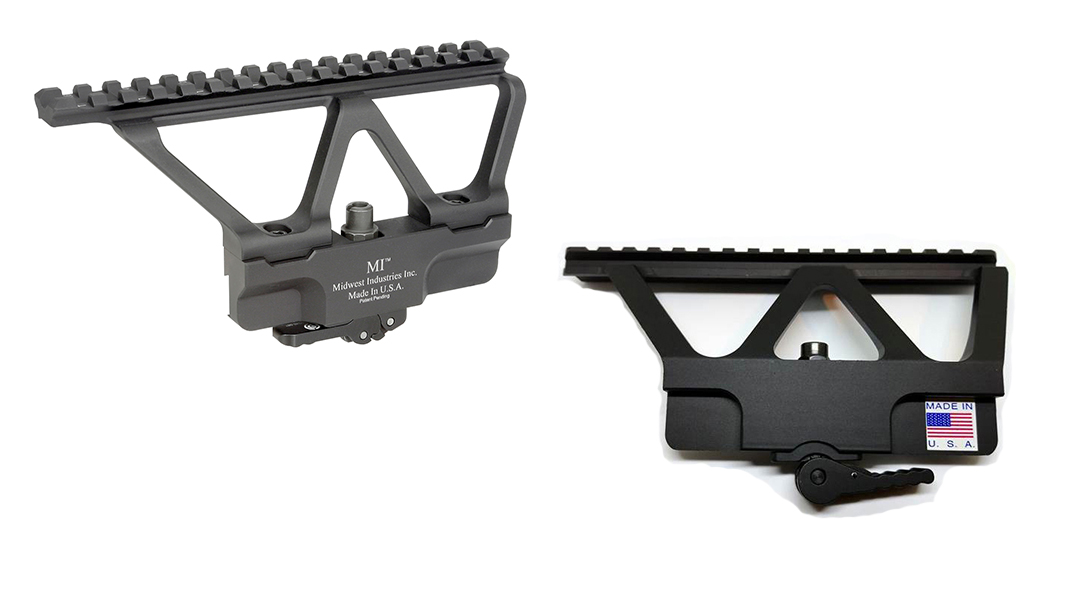The FN SCAR 16S rifle caught my eye at a law enforcement seizure auction. It looked to be low mileage and was an expensive gun for which I never would have paid retail. What clinched the deal, however, was the EOTech Holographic Weapon Sight (HWS) and Aimpoint magnifier. That sort of glass is expensive. If I could work a deal on the gun and get the optics for free, then I would feel good about it.
I landed the rifle and optics at a decent price. When I brought it home, I went through my standard ritual of tearing everything apart to learn its secrets. However, when I removed the magnifier, I noticed it had a little rattle. I gently pressed on the front lens, and it actually fell out. I had used Aimpoint products before. So has Uncle Sam. This seemed out of character.
Advertisement — Continue Reading Below
The magnifier has “Aimpoint” splashed proudly across the side. I turned to Google looking for warranty information. That’s where I discovered the sordid truth. The U.S. Patent and Trademark Office (USPTO) maintains a registry of trademarks, copyrights and patents underneath the umbrella of the Department of Commerce. To illustrate what each of these terms means, let’s suppose I just invented a revolutionary new nose-hair trimmer.
A patent protects the trimmer mechanism. A trademark covers the unique logo on the side of the chassis. A copyright guards the snappy television commercial I use to sell it. The USPTO doesn’t enforce anything. They just give you the ammunition you need to sue some company that uses your intellectual property (IP) without permission. But none of that applies outside the country. Immigration and Customs Enforcement (ICE) is tasked with criminal prosecution of those who illegally import counterfeit goods and pass them off as the real thing.
How Big Is the Problem?
Nobody really knows, but it it’s quite literally everywhere. ICE agents recently intercepted 181,000 items with a street value of $43 million in Laredo, Texas in June 2018. The month before, they found $16.1 million worth of knockoff junk. The brands involved included Under Armour, Adidas, Apple and Yves Saint Laurent.
Advertisement — Continue Reading Below
A friend at ICE told me this informally: “It’s incredibly difficult to prosecute these crimes. The country where the counterfeit products are being manufactured would first have to recognize the U.S. company’s copyright/patent and/or allow the U.S. company to file for protection in that country, and then be willing to assist and prosecute. That rarely happens. So the U.S. government can mostly just take a defensive posture. U.S. Customs and Border Protection can seize these products as they arrive at a port of entry, and ICE can investigate and arrest those who are complicit in the U.S.
“To even get to that point, however, the company that is having their IP stolen has to work closely with the government to ensure customs officials know what to look for, as copies can be incredibly sophisticated and difficult to detect.
“I’ve listened to presentations from government officials and various industry representatives on everything from counterfeit sportswear to brake pads and automotive components to the fraudulent use of the ‘UL’ logo on electronics. It’s a big deal, with huge implications for health and safety, as well as the competitiveness of U.S. companies.”
Advertisement — Continue Reading Below
This brings us to the National Intellectual Property Rights Coordination Center, or IPR Center, which coordinates the government’s response to IP theft. Surf on over to iprcenter.gov if you want a shock. Imitation goods are quite literally everywhere.
Counterfeit Combat Application Tourniquets (CATs) sport the company logo but have failed in actual use. Pirated software bought cheap from unknown sellers contains malware that can pillage your computer. Knockoff auto parts lack the quality control required to be safe on the road. Fake pharmaceuticals are sold online under the names of recognized brand names but are formulated in unsanitary conditions with unknown materials. Illicit pet food, toys and seafood have been found to contain hazardous chemicals. The scope of this thing is breathtaking. Fake tactical gear is only the smallest part of a much larger whole, but it can have serious ramifications.
From an Insider
Advertisement — Continue Reading Below
John Enloe lives this every day. He’s the manager for marketing and technical support at Aimpoint and handles most of the direct customer interactions over suspected counterfeit Aimpoint products. He has been at this for more than a decade and had some fascinating insights.
John told me that the Asian producers of this gear typically do not set out to pass their products off as the genuine article among those who use them for real. In fact, he observed that there is essentially no counterfeiting of Aimpoint’s civilian sporting optics. The pervasive problem of counterfeit tactical gear stems entirely from airsoft.
Foreign companies produce low-cost, low-performance replicas of high-end gear for use by airsoft enthusiasts. Think of these items as inexpensive toy models of the originals. Airsoft guys want to look cool, so it’s usually the latest and greatest SOCOM kit that gets the most attention. They are frequently accurate down to the markings, logos and trademarks. Unscrupulous intermediaries buy these cheap products overseas and then pass them off as the genuine articles, turning substantial profits in the process. As such, it is the domestic criminals on this side of the pond who are the real bad agents. It’s one thing if it’s knockoff underwear. But with more serious stuff, people could get hurt.
Advertisement — Continue Reading Below
John has had police officers attempt warranty returns on counterfeit Aimpoint sights that failed either in training or in actual use and were innocently shipped to Aimpoint for repair or replacement. Only then did the cop in question realize that the supposed Aimpoint optic he bought through an internet auction site at a great price was really just a child’s plaything.
Many of these sights are genuine crap. John has found examples that look great on the outside. Once he took them apart, he discovered that the glass or LED was literally shimmed in place with electrical tape. That’s not a problem when you are shooting 6mm plastic BBs. When these sights are mounted on a live weapon, however, you genuinely have no idea where your next round might go.
A young man in uniform shipped his purported Aimpoint M68 sight back for warranty repair after he returned from a combat tour downrange. His unit did not have enough sights to issue them to all their shooters, so this poor guy had his parents buy one for him and ship it over. The sight came from eBay, and his parents had no idea what they were buying beyond the nomenclature. When the guys at Aimpoint tore the thing apart, they realized that this young warrior had been engaged in combat with a cheap airsoft toy perched atop his M4.
Advertisement — Continue Reading Below
More Makers
I reached out to several of the big names in this business for commentary. Many of them were reticent to go into any great detail because of ongoing criminal investigations. Here are a few of the comments I did receive, however.
The guys at Midwest Industries produce a huge selection of rails and firearm accessories for a wide variety of popular tactical firearms. Their reputation for innovation and quality is the end result of years of toil, producing some of the finest gear on the market. So it’s obviously frustrating when someone else copies something you make at a much lower level of quality and then passes it off as genuine.
“The problem is pretty common in some of the smaller parts that we make. We see it most frequently from larger companies like Amazon. Once the customer experiences problems, they reach out to us as the manufacturer.
Advertisement — Continue Reading Below
“We know exactly where to look to determine counterfeit parts. We don’t want to say, for obvious reasons. Warranty returns or exchanges are how most of this came to light. People see the product marked down super cheap and try and save themselves a buck, then in return get shammed.
“I would say the problem has been getting better—maybe the knockoffs are becoming better quality, or companies are understanding what to look for. Regardless, you get what you pay for.”
Trijicon had this to say: “Like other premium brands, we know that unscrupulous parties attempt to dupe unsuspecting consumers into purchasing counterfeit goods. We work closely with federal authorities to take action whenever we see counterfeit Trijicon goods entering the market. The best protection for consumers is to buy Trijicon products from known and trusted dealers.”
Advertisement — Continue Reading Below
Smart Safeguards Against Counterfeit Guns
John at Aimpoint says that he runs serial number searches for potential customers all the time. Aimpoint sights, along with most other top-quality gear, sport unique serial numbers that can be cross- referenced to establish authenticity. While many of the copies are serialized as well, they are most typically engraved with a common number across all copies that can be pretty easy to spot.
Some counterfeit guns include copies of logos that are close but not perfect. The Aimpoint logo on my cheap knockoff sight is slightly italicized, while the originals are in block letters. A Google search turns up stuff like this quickly enough to be used on your phone at a gun show.
Aimpoint front lenses are always red. Some of the copies out there are either green or silver. Additionally, Aimpoint products are produced in Sweden, so inexpensive examples from obvious Asian sources are instantly suspect.
Aimpoint’s John Enloe likens this problem to playing whack-a-mole. Internet auction sites and gun show vendors pass off the cheap stuff as the originals every day. Buying from authorized factory dealers is always the best bet if you want gear that won’t fail you in a crunch.
This article is from the spring 2019 issue of Ballistic Magazine. Grab your physical copy at OutdoorGroupStore.com. For digital version, head over to Amazon.

























